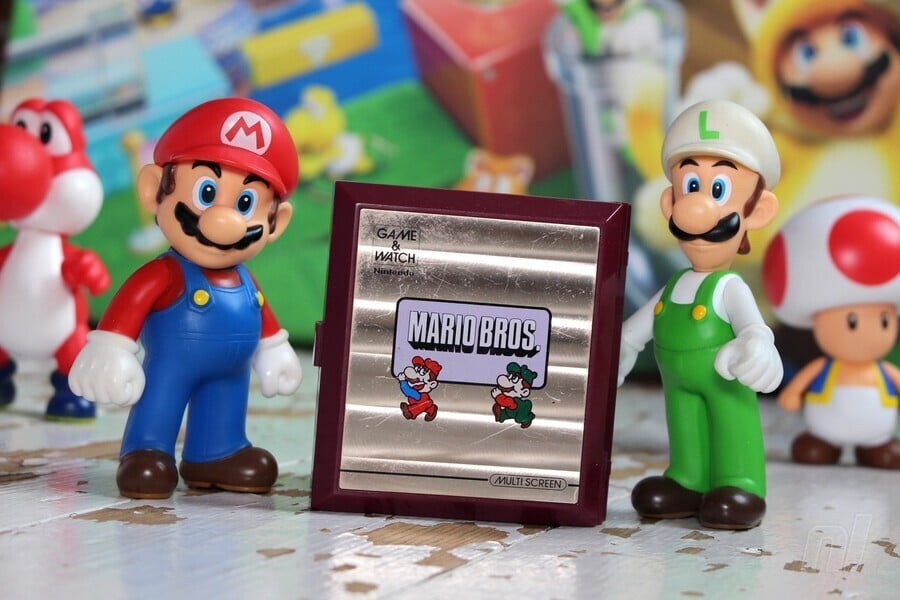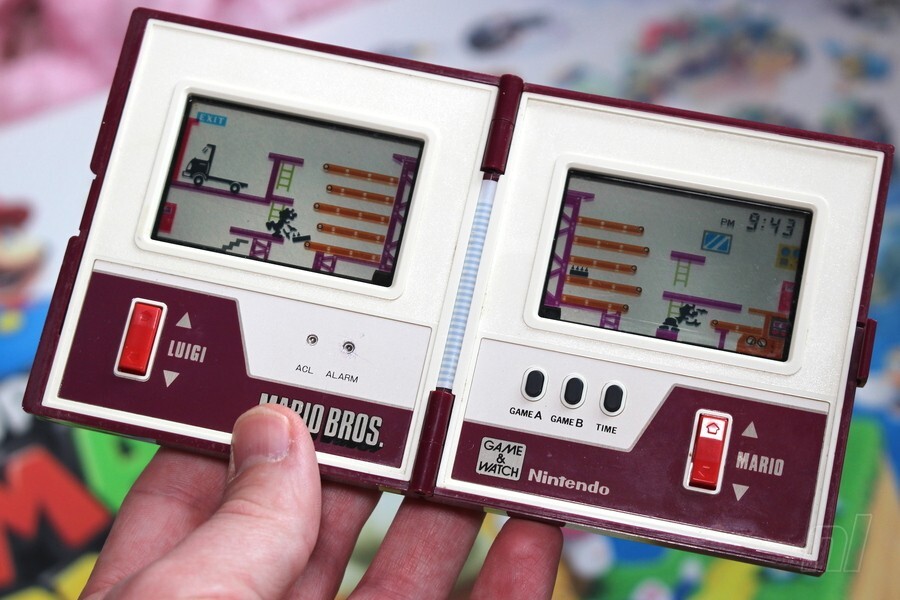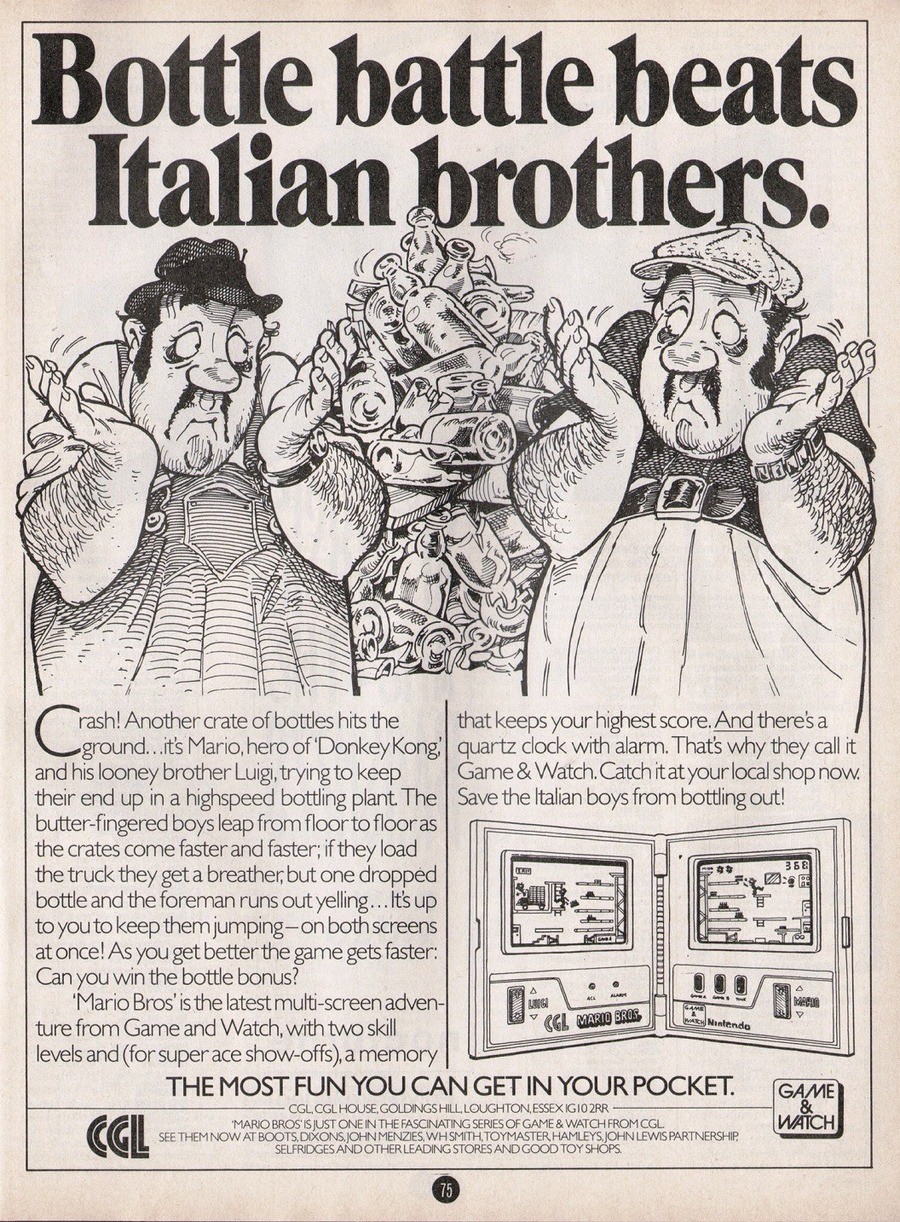
Luigi may not be quite as famous as his illustrious sibling, but there's a fair chance that you could stop a random person on the street and they'd still be able to identify him or at the very least acknowledge his association with the Super Mario Bros. series. Keeping this in mind, it's an odd sensation to play the first-ever appearance of this iconic character – and it's even odder when you consider that the setting is totally alien to rest of the series.
The 1983 Game & Watch release Mario Bros. is noteworthy for being the first of the 'Multi Screen' range to place two LCD displays side-by-side (the previous Multi Screen releases, such as Donkey Kong II, used a design which would later be seen on the Nintendo DS). However, a more important milestone is the fact that this pocket-sized title marked the debut of Luigi, and pre-dates his (arguably better known) appearance in the arcade version of Mario Bros. by four months (it released on March 14th in Japan, while the arcade game arrived on July 14th). Mario, of course, had opened his video game account in 1981's Donkey Kong.
It's perhaps understandable that this landmark release has gone unnoticed by so many, because outside of the colour artwork on the front of the unit (which, it should be noted, opens 'backwards' like a Japanese book), you wouldn't be able to tell if the two protagonists were Mario or Luigi at all; their black silhouettes lack any facial detail and they both look identical. Only the text on the unit denotes who is who.
It's also noteworthy that the signature platforming gameplay that would make Mario Bros. and its successor Super Mario Bros. so popular is absent; instead, the aim is to load a truck full of bottles by passing them from one screen to the next. You're in control of both characters in this case, using the simplistic pair of rocker controls to switch between the various conveyor belts in the factory. Because of this setup, it's possible to play Mario Bros. with a friend, making it a unique and sought-after entry in the Game & Watch line.

Outside of its historical importance, Mario Bros. is your typical Game & Watch release; despite the primitive nature of the technology used it is tightly-designed and instantly compelling, with the focus on achieving a high score ensuring that it boasts surprising longevity.
Powered by two LR44 batteries and equipped with the tremendous USP (well, for 1983 at least) of a digital clock and alarm, Mario Bros. may feel somewhat archaic by today's standards, but like pretty much every Game & Watch release, it's akin to a work of art you can hold in the palm of your hand. It's also relatively easy to find online at a reasonable price, so there's no excuse not to sample Luigi's debut and get a grounding in an important part of Nintendo history.






Comments 25
I've had more fun in my pocket lol
On another note! ... I really wish Luigi's mansion would come to switch, super bummed when they said it's out for the 3ds
The fact that the Mario Bros. are plumbers is still such a weird choice for a mascot/hero. Thank you Japan!
I like that side by side design. I guess you could say that the DS ensured there were games that used stacked and book orientations inspired by this. Nice bit of trivia-- So the first job Mario and Luigi had was at a bottling company before they became plumbers (or were they technically sewer workers?). Also, I wonder if the foreman was foreman Spike by chance... can anyone confirm his imagery? That advert though... The stereotype is strong with that one
And: "The most fun you can get in your pocket." Wow... that one writes itself
@ReaderRagfish That would have been a fair argument to make for the early 1980s. But Luigi has undergone gradual character development since then, getting his own move set and abilities as early as Lost Levels and appearing in games other than Mario Kart and other spinoffs (including his own game, Luigi’s Mansion).
I always thought a game and watch collection would be a perfect mobile (or switch) game for Nintendo.
“It's also relatively easy to find online at a reasonable price” It’s $115 USD on EBay. I’m not sure what you consider a reasonable price, but I think I’ll pass.
I have mine laying around somewhere. Was never a fan of this version of the game, even the Gallery remakes of the game weren't all that fun to me
I own quite a few G&W and this one is pretty neat, with the potential to have two players, and it’s unique with a more square shaped design. If you love Nintendo and are interested in their pre Famicom history, G&W is a great place to start.
I’d love to see more mini reviews of these on NL!!
@SimplyCinnamon53 G&W items rarely sold above 1 million units, so they're highly collectible and will cost you money. You either have a passion for this hardware or you don’t, but it certainly isn’t cheap.
Although I never owned a Nintendo (or any other brand) console until a late Gamecube purchase circa 2005, I am slightly chuffed to be able to say we did have a Donkey Kong Jr. Game & Watch in my family when I was a kid, which I got decent use out of.
Didn't look after it sadly so don't have it any more, but it was my first purchase on the 3DS eshop when I bought my N3DS.
still got mine lying around somewhere
Great article!
It's funny to see Little brother Luigi is taller than his Elder brother Mario.
Had this with my bros too ^^
Fun read. My grandma had some of the G&W units, as well as quite a few of the Tiger handhelds, and all manner of handheld games of skill. I loved playing with all of that as a kid, especially pre NES. Almost all of her stuff had been lost to time and wear and tear, but I found an old Tiger Double Dragon game the last time I rummaged around at her place. I put batteries in, and it still bleeps and bloops; so I cleaned it up and left it out. Maybe a great grandkid will find it and play it like some kind of interactive relic or fossil.
What's amazing is how good quality these things are, Nintendo didn't need to make them so nice but they have really held up, I mean look back at the alternatives, those Tiger ones were just cheap platic trash. I still have the Bombsweeper and DK Multi Screen game and watches that were bought for me back in the day and I have been waitng for a sequel to Bombsweeper for 30 years!
The most fun you can get in your pocket 😋
primitive or not... ONE YEAR of play without mains plug!
I had this growing up. And I find it Amazing that Luigi is only a couple of months older than I am. I never knew this was his first appearance, I probably ended throwing the device in the garbage.
I was a proud owner of this and Donkey Kong 2. Much later the Zelda Dual-screen G&W. Amazing how these were enough for hundreds of hours of play back then – even when you'd gotten the highest possible score multiple times. Having so many games now can be it's own challenge.
@MeloMan They were also working in a cement factory in 1983 (as seen in the game Mario's Cement Factory)
@ReaderRagfish They would have included Luigi, because no one else except Donkey Kong, Pac-Man, and Mr. Game & Watch were eligible at the time. And we need 4 players for Smash.
Well, Pauline was eligible, but she would get deconfirmed as she appears in the background of the New Donk City/75m stage. (Yes, New Donk City and 75m are canonically the same stage).
Well that is a blast from the past was given one of these as a hand me down by my cousin in the mid 90s. I had no idea it was meant to be a bottling plant I always thought it was a cake factory with more candles being added to the cake before it was packaged up. A great little game it was so satisfying when you got into a good groove and had the brothers working in harmony.
@SKTTR ah that's right! Those Mario boys got around that blue collar work lol
Luigi is "looney"? And they're "butterfingered"?
I had one of these when I was a kid but because I’m stupid I sold it years ago on eBay. Ugh can’t believe I did that STUPID STUPID STUPID.
STUPID!
Tap here to load 25 comments
Leave A Comment
Hold on there, you need to login to post a comment...